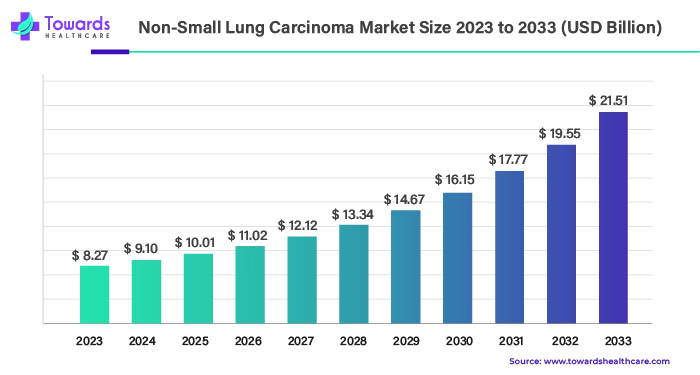March 2025

The non-small lung carcinoma market was valued at US$ 8.27 billion in 2023 and is predicted to reach US$ 21.51 billion by the end of 2033, representing an impressive CAGR of 10.03% from 2024 to 2033. Clinical research, development of new treatment options, and prevalence of NSCLC is driving the growth of the market.

Non-small cell lung cancer (NSCLC) is the most common type. Around 85% of lung cancer cases are NSCLC. This illness is caused by cancer cells found in lung tissue. While NSCLS progresses more slowly than small-cell lung cancer, it often has spread to other parts of the body by the time it is detected. Timely diagnosis and treatment are of utmost importance. The non-small lung carcinoma market is growing due to the increasing prevalence of lung cancer. The major cause of lung cancer is smoking, and other factors that contribute to NSCLC are air pollution, industrial substances, radiation exposure and tuberculosis. Early detection and treatment of NSCLC are needed.
Laboratory tests, chest X-rays, CT scans, biopsy, sputum cytology, bronchoscopy, thoracoscopy and thoracentesis are some of the diagnoses and tests that need to be done, which drive the growth of the non-small lung carcinoma market. Furthermore, treatment, medications, hospital admission, continuous monitoring, and post-treatment recovery are involved after diagnosis. With time, the cases of NSCLC are increasing; hence, the need for all the tests, treatments, monitoring and other procedures will continue to increase.

| Company Name | Pfizer Inc. |
| Headquarters | New York, U.S. |
| Pipeline |
The clinical trial is in progress, and NSCLC is being studied. According to the Pfizer Pipeline Report published in May 2024,
|
| Company Name | AstraZeneca |
| Headquarters | Cambridge, United Kingdom |
| Pipeline |
According to the pipeline report published by the company in February 2024, there are 19 projects in the pipeline that revolve around NSCLC, many of which will be submitted by 2025. Compound Name List in the Pipeline
|
Smoking is the leading cause of various cancers such as lung, stomach, pancreas, esophagus, mouth, voice box, throat, leukemia, rectum, colon, cervix, and bladder. Among all the cases of cancer, smoking is responsible for 85%. Smoking is the most common cause of NSCLC, and 95% of NSCLC cases can be prevented if restrictions on smoking are applied. Many governments have implemented various policies and regulations, like the prohibition of tobacco advertisements, to prevent smoking.
There are numerous factors that contribute to the expensive nature of carcinoma treatment. Drug development, including clinical trials and research & development, is the major factor that makes the treatment expensive because it requires huge investment in terms of time and cost. The healthcare professionals involved in the treatment procedure are highly skilled, which is why they are highly compensated. This also contributes to the costs. The technology and infrastructure involved in cancer treatment are also advanced and expensive. It becomes difficult for people who belong to poor and middle-class families and also who live in developing or underdeveloped countries. According to the WHO, 80% of active smokers live in low- and middle-income countries, which suggests that these people will not be able to afford the treatment costs if they get diagnosed with NSCLC.
The field of surgery has seen significant transformation in the past 20 years due to minimally invasive surgery (MIS). Particularly for early-stage lung cancer, techniques like robotic-assisted thoracoscopic surgery (RATS) and video-assisted thoracoscopic surgery (VATS) have taken the lead in thoracic surgery and are now considered the new norm for most surgeries. Notwithstanding these advancements, hard evidence about the therapeutic results of these minimally invasive techniques in comparison to traditional open surgery is still lacking. The frequency of minimally invasive operations is expected to continue rising in the future as lung cancer screening programs lead to an increase in the early detection of lung cancer nodules. This is going to play a significant role in the growth of the non-small lung carcinoma market.
For instance,
By type, the adenocarcinoma segment dominated the non-small lung carcinoma market in 2023. Adenocarcinoma is the most common kind of lung cancer, and the majority of lung cancers are non-small cell lung cancers (NSCLC). This kind of lung cancer represents around 40% of all lung cancer cases and 50% of non-small cell lung cancer cases. In many situations, lung adenocarcinoma can be detected in scars or regions with persistent inflammation, typically affecting the periphery of the lung. The biggest risk factor for adenocarcinoma and all other types of lung cancer is tobacco use. Other risk factors that can cause adenocarcinoma are chromium, genetics, arsenic, nickel, lung scarring, polycarbonate, pulmonary fibrosis and exposure to radiation.
By type, the squamous cell cancer segment is expected to grow at the fastest CAGR during the forecast period. The origins of squamous cell lung cancer are the thin, flat squamous cells that, when seen under a microscope, resemble fish scales. If the tumor grows very large, a chest X-ray or computed tomography (CT) scan may be used to identify a lung cavity. Biopsies, imaging examinations, and laboratory testing are a few of the methods used to diagnose lung cancer. Biomarkers are features of cancer that can be used to predict the disease's response to particular treatments. Nowadays, driver mutations discovered in the DNA of the illness and PD-L1 protein levels are used as biomarkers to inform treatment choices for squamous cell lung cancer.
By treatment, the targeted therapy segment dominated the non-small lung carcinoma market in 2023. Antagonists in targeted treatment specifically target the genes, proteins, or tumor microenvironment that promotes the growth and survival of cancer. Standard chemotherapy medications do not function in the same way as targeted treatments. They frequently have distinct adverse effects and occasionally function when chemotherapy medications don't. Currently, targeted medications are most frequently utilized, either alone or in combination with chemotherapy, to treat advanced lung malignancies. Targeted treatment is pushing the envelope to dramatically enhance patient outcomes and quality of life for advanced non-small cell lung cancer (NSCLC) patients without a confirmed driving mutation. There are several FDA-approved targeted medicines, and a large number of developing medications target these pathways. The rate at which scientific research is progressing is causing a fast change in the treatment of non-small cell lung cancer.
For instance,
By treatment, the immunotherapy segment is expected to grow significantly during the forecast period. One of the most recent treatments for metastatic non-small-cell lung cancer is immunotherapy. It is not the same as chemotherapy. Rather than targeting cancer cells while they divide, it makes use of your immune system to eradicate cancer and prevent it from spreading. Immunotherapy, which has been developed over many decades, has shown promise in producing long-lasting responses in a variety of cancer types. Over the past ten years, immunotherapy has shown to be a successful treatment strategy for non-small cell lung cancer. Patients and doctors may now customize therapy based on unique features for metastatic NSCLC because of the availability of many FDA-approved regimens.
By distribution channel, the hospital pharmacy segment dominated the non-small lung carcinoma market in 2023. Hospital pharmacies are integral to cancer treatment for several reasons. Hospitals provide a range of specialized services, including surgery, chemotherapy, radiation therapy, and other crucial medical interventions. They have the necessary infrastructure, medical equipment, and trained staff to deliver complex cancer treatments. Additionally, hospitals often have specialized oncology departments staffed with oncologists and other cancer specialists who can provide comprehensive care. Pharmacies play a vital role by ensuring that patients have access to the required medications for their cancer treatment. They dispense prescription drugs, including chemotherapy drugs, supportive medications, and pain management medications. Pharmacists also provide crucial guidance on medication usage, potential side effects, and interactions with other drugs.
By region, North America dominated the non-small lung carcinoma market in 2023 and is expected to remain dominant during the forecast period. North America is known for its advanced technology, developed healthcare infrastructure, government support and regulations, and continuous research and development. All these factors contribute to the growth of the market. The U.S. and Canada are the two major countries in the North American region that contribute to the growth.
| Estimated New Cases and Deaths in the U.S., 2024 | |||
| Male | Female | Total | |
| Estimated New Cases | 116,310 | 118,270 | 234,580 |
| Estimated Deaths | 65,790 | 59,280 | 125,070 |
The U.S. has the dominant market share in the North American region, followed by Canada. The second most prevalent cancer in the U.S. for both men and women is lung cancer, including non-small cell lung cancer. About one in five cancer fatalities in the U.S. are due to lung cancer, making it the primary cause of cancer death overall. Lung cancer claims more lives annually than the combined totals of colon, breast and prostate cancer.
By region, Asia Pacific is estimated to grow at the fastest CAGR during the forecast period of 2024-2033. Asia Pacific has both developed and developing countries that contribute to the growth of the non-small lung carcinoma market. Countries like China, India, Japan, and South Korea contribute to the growth of the market.
Lung cancer is the primary cause of cancer-related fatalities globally and the top cause of mortality for Chinese citizens. In China, the prevalence of lung cancer has been steadily rising during the previous 30 years. According to estimates, China presently sees between 0.8 and 1 million newly diagnosed instances of lung cancer each year, and for a while, this number is predicted to rise. In China, lung cancer is the primary cause of cancer-related deaths. Typically, when lung cancer is diagnosed, 65–70% of individuals have already progressed to an incurable stage. China is making efforts to tackle the prevalence of the NSCLC.
For instance,
In the case of India, the non-small lung carcinoma market is growing due to the increasing number of lung cancer cases and initiatives taken by India to tackle the issue. With 8–9 lakh cases each year, cancer is a serious public health concern. The nation has an estimated 25 lakh cases at any given time. Every year, cancer claims the lives of almost 4 lakh people. In the country, tobacco use has been connected to 40% of cancer cases. The Tertiary Treatment Cancer Centers (TCCC) initiative in India aims to develop or improve 20 State Cancer Institutes (SCI) and 50 TCCCs to provide comprehensive cancer treatment nationwide. The scheme permits a "one-time grant" of Rs. 120 crores for each SCI and Rs. 45 crores per TCCC, which may be utilized for equipment purchases and building development.
By Type
By Treatment Type
By Distribution Channel
By Region
March 2025
March 2025
September 2024
February 2025